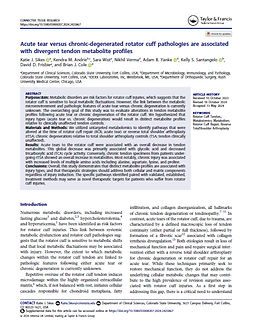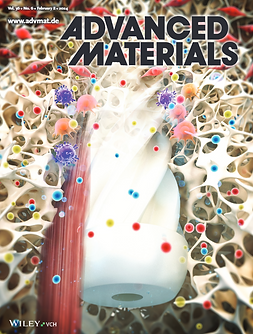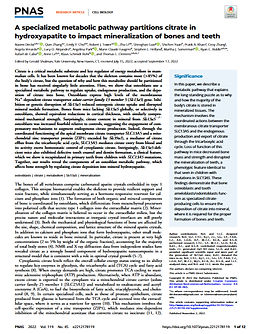Citrebind Research

Journal: Advanced Functional Materials
Publication Date: June 2025
Anionic Citrate-Based 3D-Printed Scaffolds for Tunable and Sustained Orthobiologic Delivery to Enhance Tissue Regeneration
Se-Hwan Lee, Ruqiang Lu, Andrew House, Zizhao Li, Lindsey Hammond Burton, Katie Josephine Sikes, Lynn Marie Pezzanite, Drew William Koch, Kevin Michael Labus, Ben Gadomski, Jeremiah Easley, Richard Tuan Tran, and Su Chin Heo
Objective
Bone morphogenetic protein-2 (BMP-2) has strong osteoinductive potential but clinical use is limited by the burst release of supraphysiological doses that cause adverse effects. The purpose of this study is to develop a citrate-based 3D-printed scaffold with anionic functionalization that enables sustained and localized orthobiologic delivery at lower and safer concentrations.
Conclusion
This study shows that anionic citrate-based scaffolds sequester and release BMP-2 in a controlled manner, enhancing osteogenic signaling while avoiding adverse responses. In a rabbit fusion model, these scaffolds achieved bone regeneration at doses nearly 45-fold lower than current clinical practice. The combination of hierarchical porosity, β-tricalcium phosphate reinforcement, and anionic surface chemistry establishes a safe and effective platform for orthobiologic delivery in complex orthopedic applications.
Citrate Bioenergetics

Journal: Science Advances
Publication Date: July 2025
Metabotissuegenic Citrate Biomaterials Orchestrate Bone Regeneration via Citrate-mediated Signaling Pathways
Hui Xu, Xinyu Tan, Ethan Gerhard, Hao Zhang, Rohitraj Ray, Yuqi Wang, Sri- Rajasekhar Kothapalli, Elias B. Rizk, April D. Armstrong, Su Yan, and Jian Yang
Objective
Bone regeneration requires the coordinated activity of anabolic and catabolic metabolism, yet the relationship between mTORC1 and AMPK signaling is poorly defined because they are usually viewed as antagonistic. The purpose of this study is to investigate whether citrate-based biomaterials can enable simultaneous activation of these pathways to optimize osteogenesis.
Conclusion
This study demonstrates that citrate, glutamine, and magnesium synergistically activate mTORC1 and AMPK through Akt and CaMKK2 signaling, bypassing traditional AMP and ATP sensing. The resulting dual activation sustains energy metabolism, promotes osteogenic gene expression, and accelerates bone regeneration in vivo. Incorporation of these components into a citrate-based biomaterial creates CitraBoneQMg, which provides sustained release, imaging capability, and tunable mechanics, establishing a metabolically optimized approach to orthopedic biomaterial design.

Journal: Connective Tissue Research
Publication Date: November 2024
Acute Tear Versus Chronic-degenerated Rotator Cuff Pathologies are Associated with Divergent Tendon Metabolite Profiles
Katie J. Sikes, Kendra M. Andrie, Sara Wist, Nikhil Verma, Adam B. Yanke, Kelly S. Santangelo, David D. Frisbie, and Brian J. Cole
Objective
Metabolic disorders are risk factors for rotator cuff injuries, which suggests that the rotator cuff is sensitive to local metabolic fluctuations. However, the link between the metabolic microenvironment and pathologic features of acute tear versus chronic degeneration is currently unknown. The overarching goal of this study was to evaluate alterations in tendon metabolite profiles following acute tear or chronic degeneration of the rotator cuff.
Conclusion
Acute tears to the rotator cuff were linked to an overall reduction in tendon metabolism. This overall reduction was mainly related to a decrease in tricarboxylic acid (TCA) cycle activity. In summary, this study demonstrates that distinct metabolite profiles are associated with different injury types, and that treatment strategies should target both matrix and metabolic components, regardless of the mechanism of injury.

Journal: Bioactive Materials
Publication Date: November 2024
A Functional Analysis of a Resorbable Citrate-based Composite Tendon Anchor
Arun Thirumaran, Meletios-Nikolaos Doulgkeroglou, Magesh Sankar, Jeremiah T. Easley, Ben Gadomski, Anup Poudel, Manus Biggs
Objective
Rapid and effective tendon fixation to a bone after trauma or due to degenerative processes can be achieved using a tendon anchoring device. The purpose of this study was to evaluate the potential of citrate-based composites to activate osteo-responsive signaling pathways in human mesenchymal stem cells compared to a commonly used thermoplastic material in orthopedic devices.
Conclusion
This study provides a comprehensive in vitro and in vivo analysis of the functional response to a citrate-based composite tendon anchor and shows that citrate-based composites have improved mechanical and osteogenic properties compared to commonly used resorbable tendon anchor devices made from poly(L-co-D, L-lactic acid) and tricalcium phosphate PLDLA-TCP.

Journal: Proceedings of the National Academy of Sciences
Publication Date: November 2018
Citrate-based Materials Fuel Human Stem Cells by Metabonegenic Regulation
Chuying Ma, Xinggui Tian, Jimin P. Kim, Denghui Xie, Xiang Ao, Dingying Shan, Qiaoling Lin, Maria R. Hudock, Xiaochun Bai, and Jian Yang
Objective
Differentiation of mesenchymal stem cells (MSCs) into bone-forming cells is crucial for bone regeneration, which is primarily influenced by microenvironmental factors. This study aims to investigate the impact of citrate on osteogenic differentiation and to explore the relationship between citrate, cellular metabolism, and osteogenesis.
Conclusion
This study identifies the key link through which extracellular citrate, taken up via SLC13a5, mediates metabolic regulation of cellular energy that affects the progression of human mesenchymal stem cells (hMSCs) to an osteophenotype, a process called “metabonegenic regulation.” These findings demonstrate that citrate, a metabolic factor abundant in bone, can be utilized by hMSCs to support osteogenesis by influencing metabolic pathways.
Citrate in Bone Anatomy & Physiology

Journal: Advanced Materials
Publication Date: February 2024
Enabling Pro-Regenerative Medical Devices via Citrate-Based Biomaterials: Transitioning from Inert to Regenerative Biomaterials
Huifeng Wang, Samantha Huddleston, Jian Yang, Guillermo A. Ameer
Objective
Traditional medical devices have relied on inert materials that provide mechanical support, but this approach does not actively promote tissue repair. Citrate is a metabolite central to bone physiology with intrinsic bioactivity that can be used for regenerative purposes. The purpose of this study is to establish citrate-based biomaterials as a platform for transitioning medical devices from inert supports to proregenerative systems that guide tissue healing.
Conclusion
This study demonstrates that citrate-based biomaterials combine structural performance with metabolic and biochemical signaling to enhance regeneration. By utilizing citrate’s roles in mineral chelation, metabolic regulation, and osteogenic signaling, these materials enable medical devices that support bone repair, soft tissue healing, and controlled biologic delivery. These findings position citrate-based biomaterials as a foundation for next-generation medical devices that integrate function with bioactivity.

Journal: Proceedings of the National Academy of Sciences
Publication Date: November 2022
A Specialized Metabolic Pathway Partitions Citrate in Hydroxyapatite to Impact Mineralization of Bones and Teeth
Naomi Dirckxa, Qian Zhanga, Emily Y. Chud, Robert J. Towera, Zhu Lia, Shenghao Guog, Shichen Yuanh, Pratik A. Kharei, Cissy Zhangj, Angela Verardoa, Lucy O. Alejandroe, Angelina Parkd, Marie-Claude Faugerek, Stephen L. Helfandl, Martha J. Somermane, Ryan C. Riddlea, Rafael de Cabon, Anne Lei, Klaus Schmidt-Rohrh, and Thomas L. Clemensa
Objective
It has been known for decades that the skeleton contains most (>85%) of the body’s citrate, but the question of why and how this metabolite should be partitioned in bone has received singularly little attention. The purpose of this study is to identify a metabolic pathway that explains why and how a majority of the body’s citrate is stored in mineralized tissues.
Conclusion
This study demonstrates that osteoblasts employ a specialized metabolic pathway to regulate the uptake, endogenous production, and deposition of citrate into bone. These findings demonstrate that bone osteoblasts and tooth ameloblasts/odontoblasts function as specialized citrate-producing cells to ensure the deposition of citrate into the mineral, where it is necessary for the proper formation of bones and teeth.

Journal: Proceedings of the National Academy of Sciences
Publication Date: March 2014
Citrate Bridges Between Mineral Platelets in Bone
Erika Daviesa, Karin H. Müllerb, Wai Ching Wonga, Chris J. Pickard, David G. Reida, Jeremy N. Skepper, and Melinda J. Duera
Objective
Bone is a complex composite material made up of organic and inorganic components, containing about 2% by weight of citrate; however, its role in bone remains a topic of considerable debate. The aim of this study was to characterize and suggest a new structure for bone minerals.
Conclusion
This study presents a new structure for bone mineral, where citrate in hydrated layers acts as a bridge between mineral platelets. This model can explain several observations that conflict with previous theories. The inclusion of citrate between mineral platelets accounts for the flat, plate-like shape of bone mineral crystals and may play a key role in regulating the crystallinity of bone mineral, which is closely related to the bone's mechanical properties.

